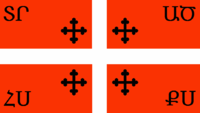Kingdom of Artsakh
| Kingdom of Artsakh | ||||||||||
| ||||||||||
|
| ||||||||||
 Syunik as vassal of the Armenian kingdom around 1000 | ||||||||||
| Capital | Khachen, Haterk, Vaykunik | |||||||||
| Languages | Armenian | |||||||||
| Religion | Armenian Apostolic | |||||||||
| Government | Monarchy | |||||||||
| King | Hovhannes-Senekerim | |||||||||
| 1000 | ||||||||||
| History | ||||||||||
| • | Established | 1000 | ||||||||
| • | Subdivision of the kingdom | 1182 | ||||||||
| • | Acquisition of Dizak and Gardman | 1261 | ||||||||
| • | Assassination of Hasan Jalal, last king of Syunik | 1261 | ||||||||
| ||||||||||
| Warning: Value not specified for "common_name" | ||||||||||
The Kingdom of Artsakh (Armenian: Արցախի թագավորություն), was a medieval dependent Armenian kingdom on the territory of Syunik, Artsakh (present-day Nagorno-Karabakh), Gardman and Gegharkunik.[1] Contemporary sources referred to it as the Khachen. The royal house of Khachen was a cadet branch of the ancient Syunid dynasty and was named Khachen, after its main stronghold. The kingdom emerged when Hovhannes-Senekerim acquired the royal title in 1000.
The kingdom was under the protectorate of the Bagratuni kings of Armenia.
Artsakh maintained its sovereign rulers, though in the early 13th century they accepted Georgian, then Mongol suzerainty.[2] They lost the royal title after the assassination of Hasan-Jalal (1214–1261) by the Ilkhanid ruler Arghun, but continued to rule Syunik as a principality, which from the 16th century comprised five Armenian melikdoms and lasted until the early 19th century.[1] The descendants of the kings of Syunik played a prominent role in the history of Syunik as far as the 20th century.
References
- 1 2 Hewsen, Robert H (2001). Armenia: A Historical Atlas. Chicago: University of Chicago Press. pp. 118–121. ISBN 0-226-33228-4.
- ↑ Hewsen, Robert H. "The Meliks of Eastern Armenia: A Preliminary Study." Revue des Études Arméniennes. NS: IX, 1972, pp. 255-329.
Further reading
- Robert H. Hewsen. "The Kingdom of Arc'ax" in Medieval Armenian Culture (University of Pennsylvania Armenian Texts and Studies). Thomas J. Samuelian and Michael E. Stone (eds.) Chico, California: Scholars Press, 1984. ISBN 0-89130-642-0.


